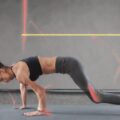Planking is a simple yet challenging core strengthening exercise that builds endurance in the abs, back, shoulders and arms. If you’re new to planking, it’s important to learn proper form before holding the position for extended periods of time.
Benefits of Planking
- Strengthens core muscles
- Improves posture
- Burns calories
- Can be done anywhere
When performed correctly, planking has many benefits for physical and mental health. However, it’s best to start slowly and focus on form in order to avoid injury.
How to Do a Plank
- Get into a press-up position, resting your weight on your toes and forearms
- Ensure your elbows are directly under your shoulders
- Engage your core by pulling your belly button toward your spine
- Keep your back flat and head/neck in neutral alignment
- Hold position for up to 60 seconds
Be sure to breathe normally and focus on maintaining proper form throughout the exercise. Start with shorter hold times of 10-20 seconds and gradually increase over time.
Common Mistakes
Here are some common plank mistakes to avoid:
- Sagging hips – Keep your body in a straight line
- Sticking your butt in the air
- Overarching your back
- Dropping your head down
- Not breathing!
Plank Variations
Once you’ve mastered a solid high plank hold, try these variations:
- Forearm Plank – Drop down onto your forearms in plank position for an easier variation
- Side Plank – Rotate onto one forearm sideways, stacking your feet or knees for added challenge
- Single Leg Plank – Lift one leg up into the air to work your stability
Frequently Asked Questions
How long should I plank for the first time?
Aim for 10-20 seconds when planking for the first time. Allow your body to get used to the exercise before attempting any long holds.
Will doing planks everyday help me get a six pack?
Planks can strengthen your core muscles and improve muscle definition over time as part of a balanced fitness routine. But results depend on your genetics, nutrition and other training.
Which muscles does the plank work?
Planks primarily target your transverse abdominis, rectus abdominis, internal and external obliques and erector spinae. They also work your glutes, shoulder and arm muscles.
Is planking safe?
Yes, planking is generally safe when performed with proper form. But be cautious if you have any wrist, elbow, shoulder or back injuries. And always listen to your body.
Can beginners plank everyday?
It’s not recommended for beginners to plank everyday. Allow rest days for your body to recover and slowly build up plank hold times. Planking 2-3 times per week is enough when getting started.









